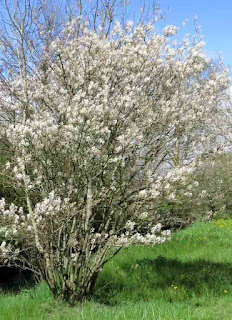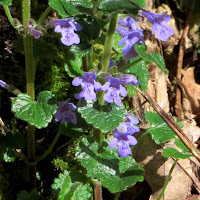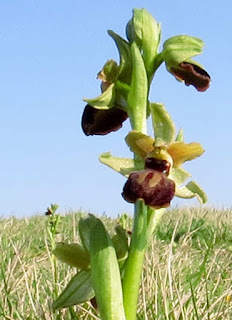"When proud-pied April dress'd in all his trim
Hath put a spirit of youth in every thing..."
- Shakespeare, Sonnet 98
 |
| "La Minoterie" - the old flour mill at Les Monards |
These early April days are some of the most eagerly anticipated in the calendar and each little rainstorm brings a new unfurling of leaves, adding yet another fine glaze of colour to the landscape.
 |
| Caltha palustris Marsh marigold or kingcup |
Here by our neighbour's lake, the gentler shades of weeping willow and dogwood are occasionally interrupted by the brash yellow of kingcups growing by the water's edge.
The Latin name caltha means "goblet" and palustris refers to the marshy areas where it thrives. Flowers are a similar colour to the buttercup but much larger, with an impressive clutch of stamens in the middle.
Shakespeare referred to them as "winking marybuds" for their reflective quality and there are now several cultivars listed in the RHS Plant Finder. A must for the water gardener and a useful way to stabilise riverbanks.
Around the lake in front of his mill, our neighbour Robert has planted a number of specimen trees, including this lovely Amelanchier or 'snowy mespilus', which lives up to its name with a soft coating of white blossom in April.
Amelanchiers can be grown as a shrub or small tree and were originally introduced from North America, although my book tells me that they have now naturalised on sandy soil in parts of southern England and the RHS has given the lamarckii variety its award of merit.
 |
| Amelanchier lamarckii |
Amelanchiers can be grown as a shrub or small tree and were originally introduced from North America, although my book tells me that they have now naturalised on sandy soil in parts of southern England and the RHS has given the lamarckii variety its award of merit.
 |
| Amelanchier lamarckii - downy buds and bronze-tinged leaves create a lovely picture early in the year |
Thanks to Robert's son, we're now growing one in our back border so that we can admire each stage of development in close-up.
Not only does it provide wonderful blossom but this is followed by red edible fruits, which turn purple-black in July - and the leaves, too, provide additional colour in autumn. What's not to like??
Damson jam?
 |
| First blossom on our brave damson tree! |
Although the above 'twigs' may look less than impressive, we feel quite blessed to have got this far with a tree which nearly died on its journey from England. Some good friends brought it over in the back of their car, knowing how much we enjoyed damson jam, but sadly it suffered a case of sunburn en route and we didn't think it would survive.
Christina planted the poor thing in her shady 'hospital' area, trimmed off the dead bits and generally treated it like a patient in need of TLC. Two years later it's growing in the open sun and looking quite perky!
Viburnums
 |
| Viburnum sargentii 'Onondaga' - just coming into leaf and bud |
Now is the time when it pays to have some viburnum in your borders so that you can enjoy its vanilla-scented blooms.
There are many different cultivars and, as this picture shows, their leaves can also provide some subtle colouring.
In the case of 'Onondaga', its leaf starts out maroon and gradually turns green, while the tiny flower buds are also dark red and go on to produce dainty white blooms, resembling those of a small lacecap hydrangea.
 |
| Cerinthe major 'Purpurascens' - a Mediterranean herb related to bora |
Annuals like myosotis, nigella and cerinthe have generously seeded themselves all over our garden and in spring we find ourselves pulling up a lot of these flowers in order to make space for something new.
Cerinthe thrives in sunnier beds and can easily cover up other more delicate perennials with its thick, glaucous foliage and rather tough roots.
In some ways it's a pest but we keep a few because the colourful purple bracts hide tiny flowers which are surprisingly attractive to insects.
 |
| A planter (or raised bed) made to accommodate our spreading acer and underplanted with bulbs. - Note the matching seed table! |
 |
| Tulip 'Lilac Wonder' |
Once you've filled up your beds and borders (as we have) it becomes difficult to find space for bulbs like narcissi and tulips which require a deep planting hole.
Add to that the fact that our soil is full of rocks and it becomes a back-breaking task to plant anything!
 |
| Tulip "Ballerina" with "Apricot Emperor" in foreground |
Christina has developed a useful skill in making her own planters with planks from the local woodyard (cheap) or recycling the old slats from Ikea beds (even cheaper).
Once they've been treated with a coat of flat paint, they look positively stylish!
We also have a couple of heavy copper cauldrons ("chaudrons" in French) bought at local brocantes, which provide just enough depth for most tulips.
Planting is a lot easier when using compost rather than soil, but it's important to feed the bulbs after flowering otherwise they may not come back the following year.
The "Apricot Emperor" in this picture are but a pale reflection of what they were last spring, due to lack of feed, and some didn't flower at all.
Wild flowers
On days when the wind is particularly cold, it's better to walk in woodland where you have some protection.
This little ground ivy is one of the earliest plants to catch one's eye: it's part of the dead nettle family and has blue to mauve pea-like flowers, with heart-shaped leaves.
Apparently it was once used as a bitter additive for beer when hops were not available!
Out on the windswept downs, however, our first orchids have appeared: in this case the Early Spider Orchid (Ophrys sphegodes) with pale green foliage and contrasting brownish-maroon flowers.
Once they've been treated with a coat of flat paint, they look positively stylish!
We also have a couple of heavy copper cauldrons ("chaudrons" in French) bought at local brocantes, which provide just enough depth for most tulips.
Planting is a lot easier when using compost rather than soil, but it's important to feed the bulbs after flowering otherwise they may not come back the following year.
The "Apricot Emperor" in this picture are but a pale reflection of what they were last spring, due to lack of feed, and some didn't flower at all.
 |
| Glechoma hederacea or ground ivy |
On days when the wind is particularly cold, it's better to walk in woodland where you have some protection.
This little ground ivy is one of the earliest plants to catch one's eye: it's part of the dead nettle family and has blue to mauve pea-like flowers, with heart-shaped leaves.
Apparently it was once used as a bitter additive for beer when hops were not available!
 |
| Ophrys sphegodes Early spider orchid |
Out on the windswept downs, however, our first orchids have appeared: in this case the Early Spider Orchid (Ophrys sphegodes) with pale green foliage and contrasting brownish-maroon flowers.
A host of these orchids have suddenly popped up in one of the chalky meadows overlooking the estuary.
It's grazed by rabbits and I did find one flower stem that looked as if it might have been nipped off at the base, but on the whole I think they stick to munching grass...
It's grazed by rabbits and I did find one flower stem that looked as if it might have been nipped off at the base, but on the whole I think they stick to munching grass...
 |
| Wind-scoured fields on limestone uplands |

Orchids growing wild in the field? . ..You ARE living in paradise. ..very charming. ..
ReplyDelete